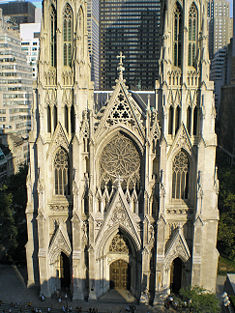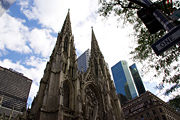St. Patrick's Cathedral, New York
| St. Patrick's Cathedral, New York city | |
|---|---|
| (U.S. National Historic Landmark) | |
 |
|
| Location: | Manhattan, New York |
| Coordinates: | |
| Built/Founded: | 1858-78 |
| Architect: | James Renwick, Jr. |
| Architectural style(s): | Gothic revival |
| Designated as NHL: | December 8, 1976 [1] |
| Added to NRHP: | December 8, 1976 |
| NRHP Reference#: | 76001250 |
| Governing body: | Roman Catholic Archdiocese of New York |
St. Patrick's Cathedral is a decorated Neo-Gothic-style Catholic cathedral church in North America. It is the seat of the archbishop of the Roman Catholic Archdiocese of New York, and a parish church, located on the east side of Fifth Avenue between 50th and 51st Streets in midtown Manhattan. It faces Rockefeller Center.
Contents |
History
Purchase of the property
The land on which the present cathedral sits was purchased for $11,000 on March 6 1810, as a site for a school for young Roman Catholic men to be conducted by the Jesuits. This school failed, and in 1813 the land was sold again to Dom Augustin LeStrange, abbot of a community of Trappists (from the original monastery of La Trappe) who came to America fleeing persecution by French authorities. In addition to a small monastic community, they also looked after some 33 orphans. With the downfall of Napoleon in 1814, the Trappists returned to France, abandoning the property. The orphanage was maintained by the Diocese of New York into the late 1800s. Some of the monks resettled to Canada and eventually founded St. Joseph's Abbey in Spencer.
Construction of the cathedral
The Diocese of New York, created in 1808, was made an archdiocese by Pope Pius IX on July 19, 1850. On October 6, 1850, Archbishop John Joseph Hughes announced his intention to erect a new cathedral to replace the Old St. Patrick's Cathedral in downtown Manhattan. The "Old Cathedral" had been destroyed by fire in 1866 but was rebuilt and rededicated by 1868.
The new cathedral was designed by James Renwick, Jr. in the Gothic Revival style. The cornerstone was laid on August 15, 1858, just south of the diocese's orphanage. At that time, midtown Manhattan was far north of the populous areas of New York City.
Work was begun in 1858 but was halted during the Civil War and resumed in 1865. The cathedral was completed in 1878 and dedicated on May 25, 1879, its huge proportions dominating the midtown of that time. The archbishop's house and rectory were added from 1882 to 1884, and an adjacent school (no longer in existence) opened in 1882. The Towers on the West Facade were added in 1888, and an addition on the east, including a Lady Chapel, designed by Charles T. Mathews, was begun in 1901. The stained glass windows in the Lady Chapel were designed and made in Chipping Campden, England by Paul Vincent Woodroffe between 1912 and 1930. The cathedral was renovated between 1927 and 1931, when the great organ was installed and the sanctuary enlarged.
The cathedral and associated buildings were declared a National Historic Landmark in 1976.[1][2][3]
Architectural features

- The cathedral is built of white marble quarried in New York and Massachusetts and can accommodate 2,200 people.
- The cathedral is bounded by East 51st Street to the north, Madison Avenue to the east, East 50th Street to the south, and Fifth Avenue to the west.
- The spires rise 330 feet (100 meters) from street level.
- The windows were made by artists in Chartres, Birmingham and Boston. The great rose window is one of Charles Connick's major works.
- The St. Michael and St. Louis altar was designed by Tiffany & Co.. The St. Elizabeth altar was designed by Paolo Medici of Rome.
- The St. John Baptist de la Salle altar remains one of the few original side chapel altars commemorating the patron saint of catechists and teachers. The adjoining stain glass window depicts the Bull of Approbation granted by the Vatican to the Institute of the Brothers of the Christian Schools who, since 1848, have conducted numerous parish grade and high schools throughout the Archdiocese of New York, as well as Manhattan College and Lincoln Hall.
- The cathedral's Stations of the Cross won a prize for artistry at the World Columbian Exposition in Chicago in 1893.
- The pietà is three times larger than Michelangelo's Pietà. It was sculpted by Araldo Perugi, who immigrated from Carrara, Italy.
- A bust of Pope John Paul II is located in the rear of the cathedral, commemorating his visit to the city in 1979.

- Archbishop Francis Spellman, later cardinal, undertook a major renovation of the main altar area of the cathedral in the late 1930s and early 1940s. The bronze baldachino in the sanctuary is part of this work, and the former high altar and reredos that stood there were removed and replaced. The original High Altar of St. Patrick's is now in the University Church of Fordham University at Rose Hill in the Bronx (Spellman's alma mater). Coincidentally, that church, built in the 1830s, is also home to stained glass windows donated by King Louis Philippe of France for the Old St. Patrick's Cathedral downtown when it was originally being built. The windows were installed in the Fordham church when it was discovered that they did not fit in the Old St. Patrick's. Clendenin James Ryan donated the Rose window. He was the grandson of Thomas Fortune Ryan and Ida Barry Ryan who built St Jean Baptist on 78th and Park Avenue.
- In the 1980s, John Cardinal O'Connor undertook further renovation work, most notably the construction of a new stone altar in the middle of the sanctuary, closer and more visible to the congregation. It was built from sections of one of the side altars that was removed to reposition the baptismal font in the north transept.
- The roof is made from slate from Monson, Maine.
Organs

The original pipe organs, built by George Jardine & Son in the 19th century, have been replaced. The Chancel Organ, in the north ambulatory, was made by the St. Louis firm of George Kilgen & Son, and installed in 1928. It has 39200 pipes. The Grand Gallery Organ, by the same company, was installed in 1930, and has 5918 pipes. [1]
The combined organs, totaling 177 stops and 9838 pipes, can be played from either of two five-manual consoles installed in the early 1990s to replace the original Kilgen consoles.
Burials

- The eight past cardinals, of the cathedral are laid to rest there. Four of the Cardinals' galeros are located high above the back of the sanctuary. Cardinal Spellman's galero was also worn by Pope Pius XII when he was Cardinal. John Cardinal O'Connor had Toussaint's remains moved from the old cemetery of St. Patrick to the crypt below the main altar of the present St. Patrick's Cathedral. The process of canonization of Pierre Toussaint is underway.
Archbishop Cardinals Spellman and Terence Cooke, are also buried in the crypt, along with Msgr. Michael J. Lelle, rector of the cathedral in the 1900s. Unverified, Lavelle is possibly entombed there as well. Also buried there are two other candidates for canonization...Archbishop Fulton J. Sheen and Terrance Cardinal Cooke, both of whom are now declared "Servant of God".
Some notable people whose funeral Masses were said at the cathedral include New York Yankee greats Babe Ruth and Billy Martin, legendary football coach and Fordham University alumnus Vince Lombardi, singer Celia Cruz, United States Senator from New York Robert F. Kennedy, and New York Giants owner and Fordham University alumnus Wellington Mara. Special memorial Masses were held at St. Patrick's following the deaths of Andy Warhol, Joe DiMaggio, and author William F. Buckley, Jr..
St. Patrick's in popular culture


The 1956 film Miracle in the Rain was filmed in the Cathedral.
Nelson DeMille's 1981 novel, Cathedral, concerns a fictional seizure and threatened destruction of St. Patrick's Cathedral by members of the Irish Republican Army. Much of the novel is set in and around St. Patrick's Cathedral, and details of the cathedral's structure contribute important elements to the plot.
In December 1989, approximately 5,000 ACT UP protestors arrived at St. Patrick's Cathedral during Mass in a demonstration directed toward the Roman Catholic Archdiocese's public stand against AIDS education and condom distribution in public high schools, as well as its opposition to abortion rights.[4] A short documentary about the protest, titled "Stop the Church", was originally scheduled to air on PBS. The documentary was eventually dropped from national broadcast by PBS, but still aired on public television stations in several major cities including New York, San Francisco and Los Angeles.[5]
The cathedral, and the gravestones are featured in the Whitlams song "When Fondness Makes the Heart Grow Absent" from the album Little Cloud.
Progressive heavy metal band Savatage's 1991 album Streets: A Rock Opera features a song called "St. Patrick's" during which the main character, DT Jesus, speaks to God in the cathedral demanding an explanation for his misfortunes.
In August 2002, radio shock jocks "Opie and Anthony" broadcast a couple having sex in a vestibule in the cathedral. The DJs were suspended from WNEW-FM a week later and their show was subsequently cancelled.[6]
The cathedral appeared on the movie Spider-Man, when Spider-Man saves Mary Jane Watson and leaves her on a roof-garden near the cathedral.
The cathedral features prominently in Nelson DeMille's 1981 novel, Cathedral, and James Patterson's 2007 novel, Step on a Crack.
The underground ruins were the setting for the climax of Beneath the Planet of the Apes where Taylor destroyed the Earth with the Alpha-Omega bomb.
The cathedral was used as the venue for the wedding of Wilhelmina Slater to Bradford Meade in hit ABC prime-time show Ugly Betty.
The cathedral ranked 11th out of 150 buildings in the recent list of America's Favorite Architecture. [7] 17499
See also
- List of Roman Catholic Bishops and Archbishops of New York
References
- ↑ 1.0 1.1 "St. Patrick's Cathedral, Lady Chapel, Rectory and Cardinal's Residence". National Historic Landmark summary listing. National Park Service (2007-09-18).
- ↑ "[http://pdfhost.focus.nps.gov/docs/NHLS/Text/76001250.pdf "St. Patrick's Cathedral, Lady Chapel, Rectory, and Cardinal's Residence". August 1976, by Carolyn PittsPDF (368 KiB) National Register of Historic Places Inventory-Nomination]". National Park Service (1976-08).
- ↑ "[http://pdfhost.focus.nps.gov/docs/NHLS/Photos/76001250.pdf St. Patrick's Cathedral, Lady Chapel, Rectory, and Cardinal's Residence--Accompanying 1 photo, exterior of church under construction.PDF (193 KiB) National Register of Historic Places Inventory-Nomination]". National Park Service (1976-08).
- ↑ ACT UP. 10 Year Anniversary of "Stop the Church" Accessed 4 July 2007.
- ↑ Steinfels, Peter. (September 13, 1991) Channel 13 to Show Film on AIDS Protest New York Times. Accessed 4 July 2007.
- ↑ The Smoking Gun: Archive
- ↑ FavoriteArchitecture.org
External links
- St. Patrick's Cathedral Website
- St. Patrick’s Cathedral — New York Architecture Images
|
||||||||||